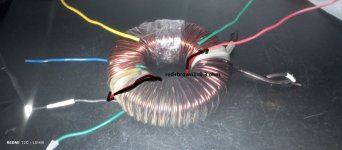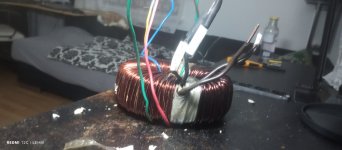Hi Sten,
A quick and dirty way would be to put a voltage of only a few volts (AC of course!) on the red-brown wires. Then measure the other wires (don’t touch ‘em, work safe!). If you get nothing on either wire combination, the transformer must be broken.
Regards, Gerrit
A quick and dirty way would be to put a voltage of only a few volts (AC of course!) on the red-brown wires. Then measure the other wires (don’t touch ‘em, work safe!). If you get nothing on either wire combination, the transformer must be broken.
Regards, Gerrit
So you have tried using diode check to verify continuity with all the wires? For instance, black DMM probe on RED, and then touch your red probe to every other wire and notate what resistance (or beep).
I would set up an excel sheet with all the colors of wires going across the top and down the left hand side. Then when you come to a combination that is connected (write down the resistance) and when you come to a pair that isn't connected (mark with an X).
Then you can methodically figure out specifically which wires are in the Primary and which are Secondary. Then you use the resistance to try and determine which Secondaries go together.
Worse case, use @gerrittube suggestion to applly low AC voltage to the Preimary and then you see what voltage appears on the other pairs of wires you previous paired using the DMM.
I would set up an excel sheet with all the colors of wires going across the top and down the left hand side. Then when you come to a combination that is connected (write down the resistance) and when you come to a pair that isn't connected (mark with an X).
Then you can methodically figure out specifically which wires are in the Primary and which are Secondary. Then you use the resistance to try and determine which Secondaries go together.
Worse case, use @gerrittube suggestion to applly low AC voltage to the Preimary and then you see what voltage appears on the other pairs of wires you previous paired using the DMM.
Strange winding. If I look at the first photo it looks like the windings are separated at the white tape, more or less where you have drawn for the red-brown wires. One side has another section of wire than the other side. Normally a torodial transformer has his primar👍(ies) and secondar👍(ies) going round the whole way.
Is this a DIY wound transformer or a commercial item?
Is this a DIY wound transformer or a commercial item?
actually i found it inside dirty old staff (before it looked really dirty, cleaned it with isopropyl alcohol and toothbrush )
sadly there wasnt any name or markings like serial nr or something🙁
but i quess its commercial item it
but i will do diode check tomorrow and let know what it shows
Thank you all for replies🙂
sadly there wasnt any name or markings like serial nr or something🙁
but i quess its commercial item it
but i will do diode check tomorrow and let know what it shows
Thank you all for replies🙂
Maybe (this post) might be useful if you have an oscilloscope. Or if you don't, (the PhaseDots PCB) may help.
I doubt it. Commercial transformers have insulating tape around the outside. They also have labels with manufacturer information, part number, etc.but i quess its commercial item it
I wouldn't personally use that transformer.
Tom
- Home
- Amplifiers
- Power Supplies
- Need some help detect toroidal transformer wiring?


